A Furlogh in Rome ( part one)
On 4 June 1944, Rome became the first Axis capital to fall to the Allies. Not long after that Allied Servicemen returned to the Eternal City as tourists. Among them, was former Buxton College pupil Heinz Thannhauser who was serving with the US Army Air Force in Sardinia. After flying a number of bombing missions over Italy in a B26 Marauder. Thannhauser who had been a professor of Art History finally got an opportunity to take a break from the war and visit some of the artistic sites that he had studied but not had the opportunity to visit. Thannhauser wrote an account of his visit . On a recent visit to Rome, I tried to retrace his footsteps. He visited in June, I was there in November as you can see from the skies.
Rome had suffered several thousand civilian casualties from bombing, but its historic centre had remained relatively undamaged. On 16 July 1943, the working class district of San Lorenzo around the railway freight yard of the same name was destroyed, and 3,000 Italian civilians were killed in the raids. In the afternoon, the second target was the "Scalo del Littorio" on the northern side of Rome. The third target was the Ciampino airport, on south-east side of Rome. Three days later on 19 July ,during Operation Crosspoint, the same area was bombed again. Arriving at Roma Termini today , the traveller can note the number of railways heading to station , and to the east were substantial marshaling yards. Unfortunately, as a vital transport node, the area made an attractive target for strategic bombing. Pope Pius XII, along with Msgr. Montini (later Pope Paul VI), emerged from the Vatican and travelled to the Basilica of San Lorenzo fuori le mura , which had been badly damaged, and distributed 2 million lire to the crowds.
By this time the Italians were now making secret peace moves with the allies in Lisbon and the Italian Government declared Rome an Open City on 14 August 1943. Thereafter the bombing was confined to attacks on the Ciampino, Guidonia and Centocelle airfields and to the Tiburtino, Littorio and Ostiense marshalling yards to disrupt railway communications. The bombings of the "Eternal City" were controversial , not only for the risk of destroying its artistic patrimony and the civilian deaths , but also the presence of the neutral Vatican City , and the many Vatican owned churches and other buildings outside its territory but within Rome city limits. Many Americans were against a major destruction of Rome. However, the British War Cabinet refused to see bombing Rome as a crime against humanity, apparently still remembering, the rather ineffective Italian participation in the London Blitz. .Following the Italian Armistice on 8 September 1943, Rome was bravely and ineffectively defended by various units loyal to the Italian Royal government, before falling to a further nine months of German occupation, while Allied armies slogged their way up from the toe of Italy.
In late May 1944, the Allies finally broke out of the Anzio beach head and advanced to Rome. As the Germans prepared to leave , they declared the city to be an open city , which was rather more meaningful in a legal sense, then the previous Italian declaration. In this case, the Germans intended that they would evacuate the city and did not intend to defend it , which given the proximity of the Americans was more in keeping with the normal usuages of war. Following the Liberation , Rome opened for American tourism again. Although there was a war going on, many GI’s still had time for leisure. Aircrews had time off between missions, sailors enjoyed shore-leave and a large proportion of soldiers were not actually combatants, but in logistical or support roles . Even infantrymen, got time off for a little tourism. Soldier tourism was encouraged by the American military authorities. After the liberation, the newspaper Stars and Stripes set up shop in the offices and printing presses of Il Messagero and published its “When in Rome Column “. The Americans established their Rome HQ in Villa Torlona, Mussolini’s former residence. They maintained the status of an Open City. with most Allied troops passing the outside of the city on the way north and it was not used for troop concentrations, with military activity being limited to hospital, HQ Units and the Military Government. Against this background, Thannhauser took a furlough from his unit in Sardinia and flew across to Rome for a few days. He described the trip in a letter to his parents, who were by that time had managed to reach the United States. Extracts from the letter were later published in “The College Art Journal” in 1945, under the title “A Furlough in Rome”. The article concentrates on the art and architecture of Rome , Thannhauser was a good writer and so it is a shame that his other impressions of a Rome newly occupied by the Americans have apparently not survived.
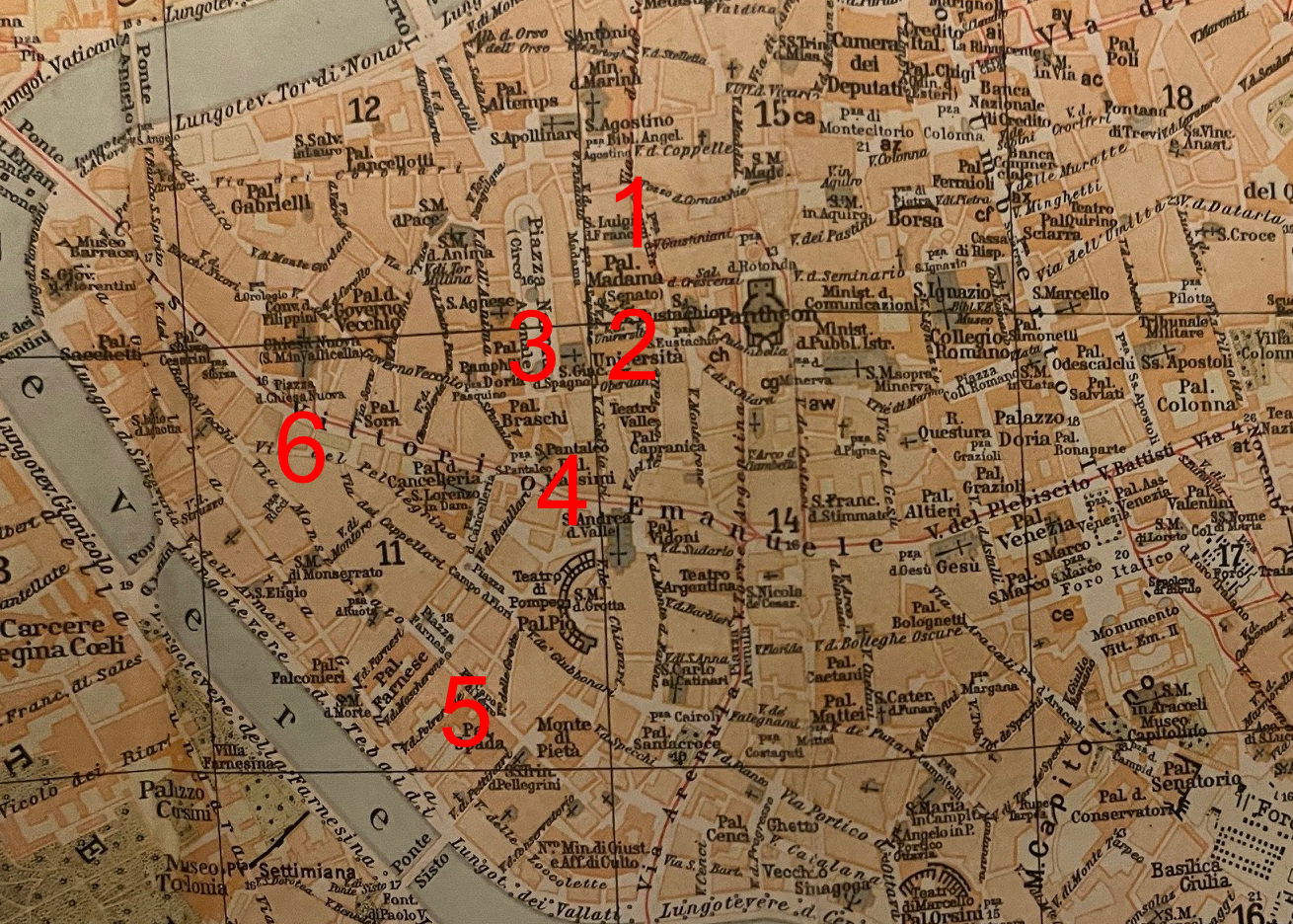
1. San Luigi dei Francesi 2. Sant'Ivo alla Sapienza 3.Sant’ Agnese in Piazza Navona 4. Sant 'Andrea della Valle 5 Palazzo Farnese 6 Santa Maria della Vallicella
Thannhauser headed first for the area around piazza Navona, his first stop was the Church of San. Luigi dei Francesi, where he wanted to look at the Caravaggio pictures; unfortunately, he was unable to visit since there was a mass and celebration there by French troops who formed part of the US 5th Army . San Luigi dei Francesi is dedicated to the Virgin Mary, St. Denis the Areopagite and St. Louis IX, King of France. The church was designed by Giacomo della Porta and built by Domenico Fontana between 1518 and 1589, and completed through the personal intervention of Catherine de' Medici, who donated to it some property in the area. The church was consecrated by the Cardinal François de Joyeuse, Protector of France before the Holy See, on 8 October 1589. The interior was restored by Antoine Dérizet between 1749 and 1756. As the French church in Rome, it was natural for the French troops to celebrate mass there.
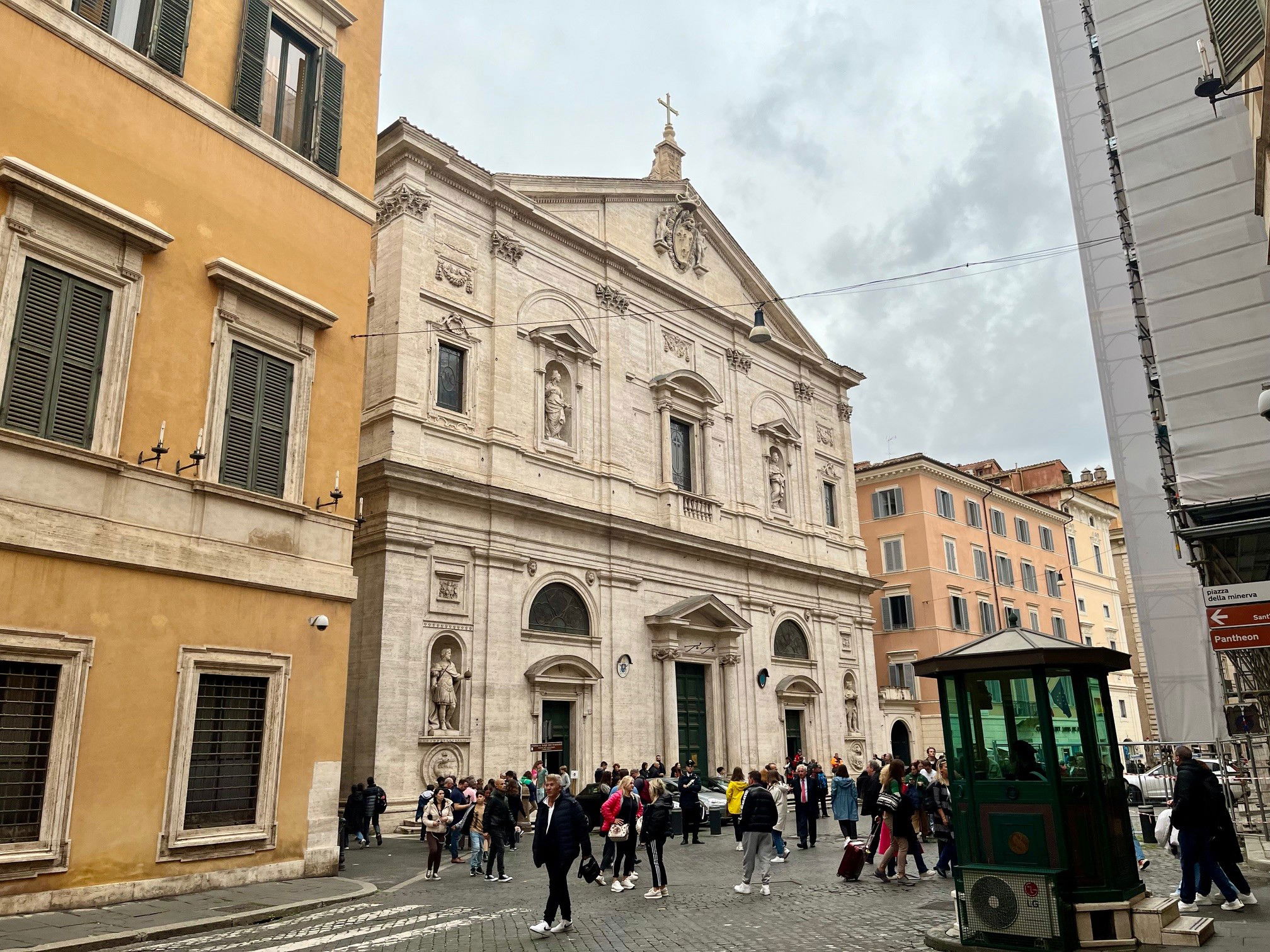
The church of San. Luigi dei Francesi, the French church in Rome
On entering the church, there are a number of monuments to the comrades of those French soldiers who perished in the Italian campaign. Possibly due to the notorious episodes of rape and pillage carried out by Moroccan and Algerian colonial troops, the French contribution to the Italian campaign is overlooked. The Corps Expéditionnaire Français, CEF consisted of 112,000 men , over 60% of whom were Algerian and Moroccan with French officers. The French troops had fought at Monte Cassino and then formed part of the breakthrough at the Gustav line in May 1944. 6,500 were killed in action. Although the Moroccan Goumiers had a reputation as the best mountain fighters with the Allies, during the advance on Rome, they gained an appalling reputation for rape and looting, which bought shame on the honour of the French Army Appalled by the situation, French officers summarily shot or hung the offending soldiers, and several hundred were tried and imprisoned. While it is correct to draw attention to the excesses of the colonial troops, the monuments in San Luigi attest to a more honourable France.
Among those commemorated is Major Jean Tatin. A 42 year old from Aube, Tatin commended a rear-echelons pioneer unit, the 3/202 RPNA. He requested a transfer to the front-line and was sent to the Tabors a Moroccan unit, who were engaged with Germans who were still dug in Monte Schierano. Tatin lost his life during the violent struggle to take the hill. on 23 May 1944.
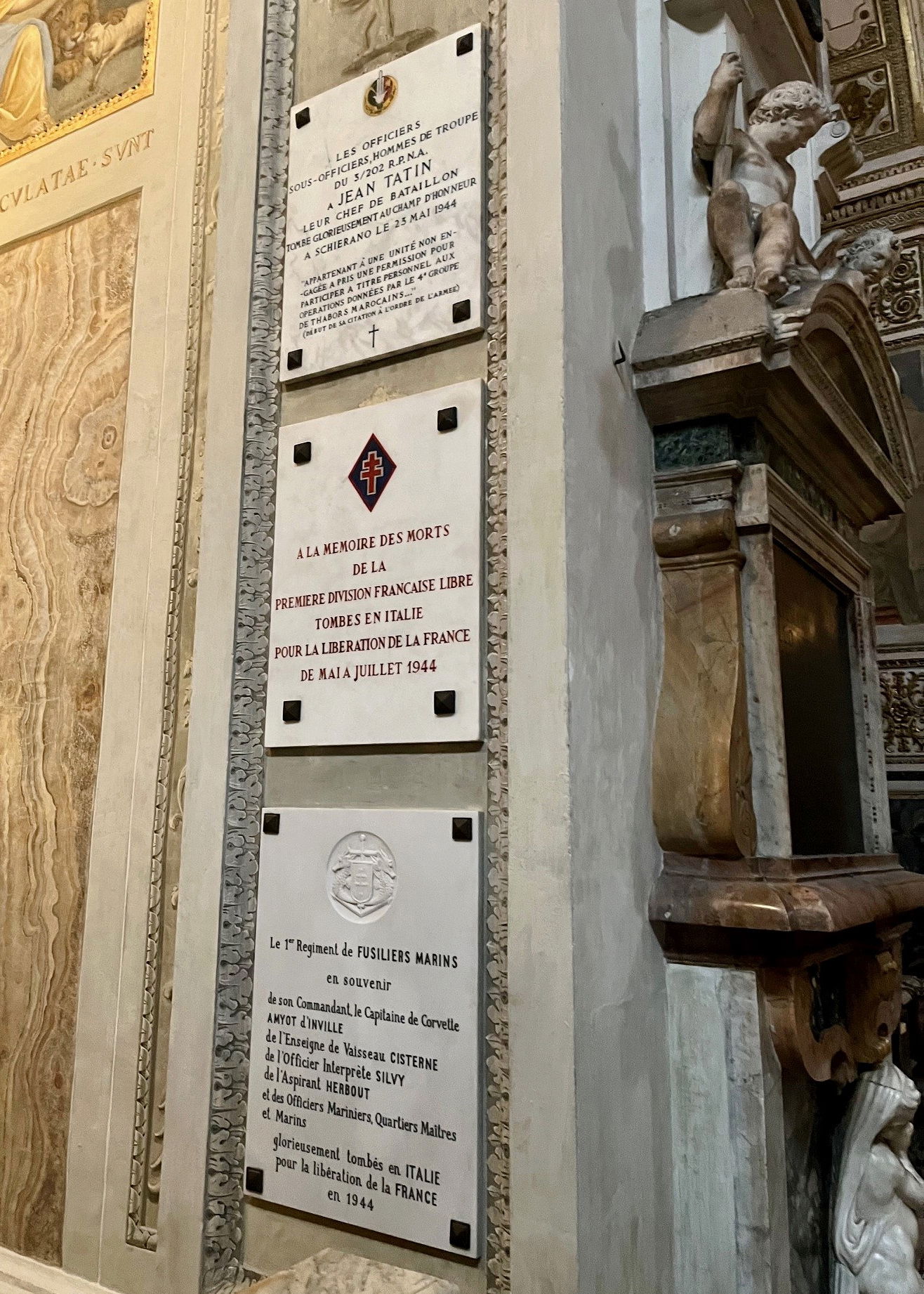
San. Luigi dei Francesi- memorials to French units which fought in the Italian campaign
Most of the tourists seem to ignore the French memorials and make a beeline for the Caravaggio paintings that Thannhauser had so wanted to see. The Contarelli Chapel contains his cycle of paintings on the life of St. Matthew. This includes the three world-renowned canvases of The Calling of St Matthew (on the left wall), The Inspiration of Saint Matthew (above the altar), and The Martyrdom of Saint Matthew (on the right wall).
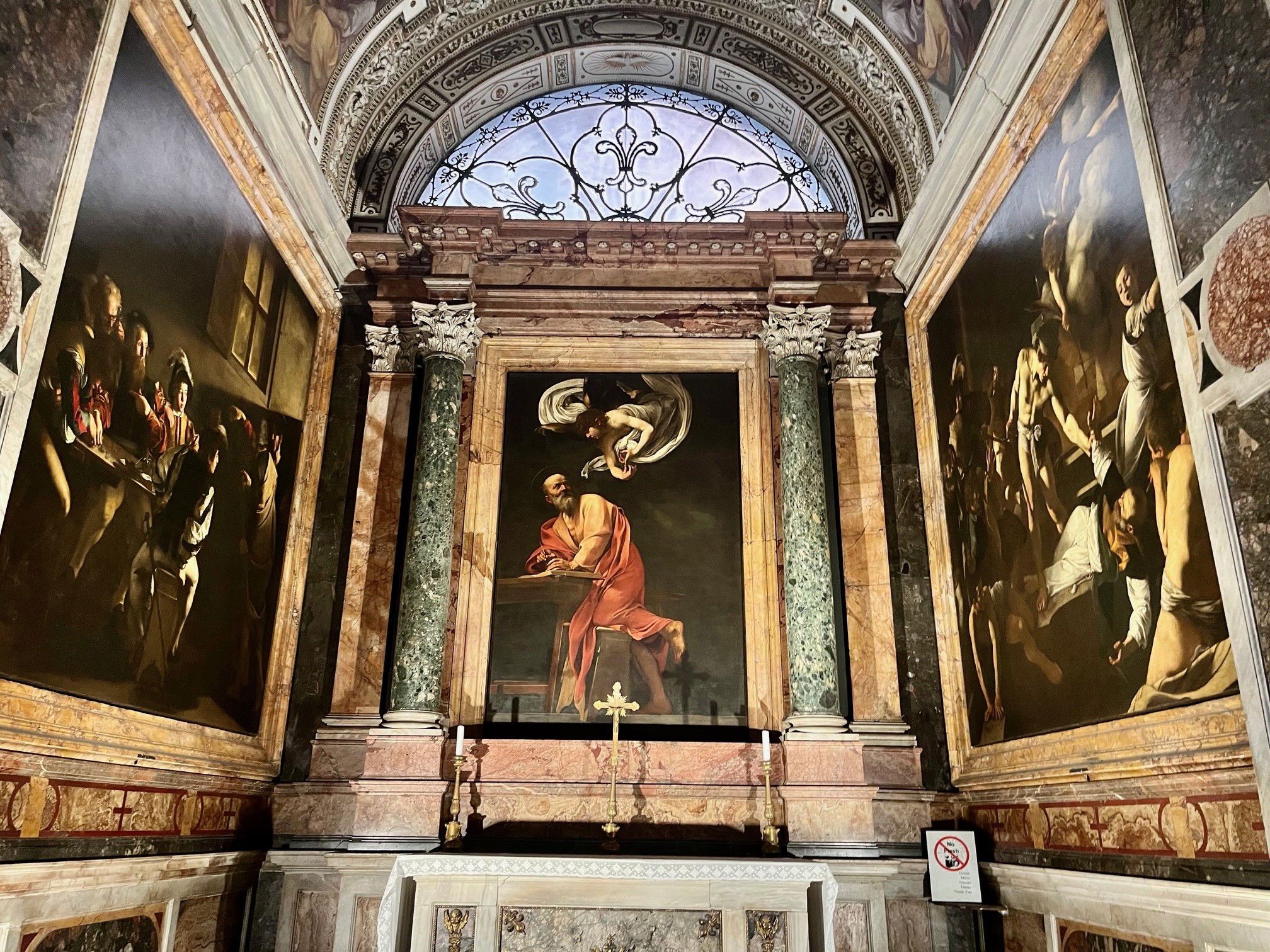
San. Luigi dei Francesi- Caravaggio's Saint Matthew canvases
On leaving San Luigi , Thannhauser strolled round the corner and into Corso Rinascimento at for the church of Sant'Ivo alla Sapienza (lit. 'Saint Ivo at the Sapienza (University of Rome)'). Built in 1642–1660 by the architect Francesco Borromini, the church is widely regarded as a masterpiece of Roman Baroque architecture. The church rises at the end of a courtyard, known as the courtyard of Giacomo della Porta. The façade is concave, molding the church into the courtyard as if completing it rather than disrupting it. The façade itself looks like a continuation of the courtyard arches except with the openings filled in with small windows, a door, and a larger glass window above the door. A key exterior aspect is the top of the church: the lantern of Sant'Ivo is topped with a spiral shape, surmounted by a Cross. Again the church was closed and Thannhauser had to content himself with looking at the outside.
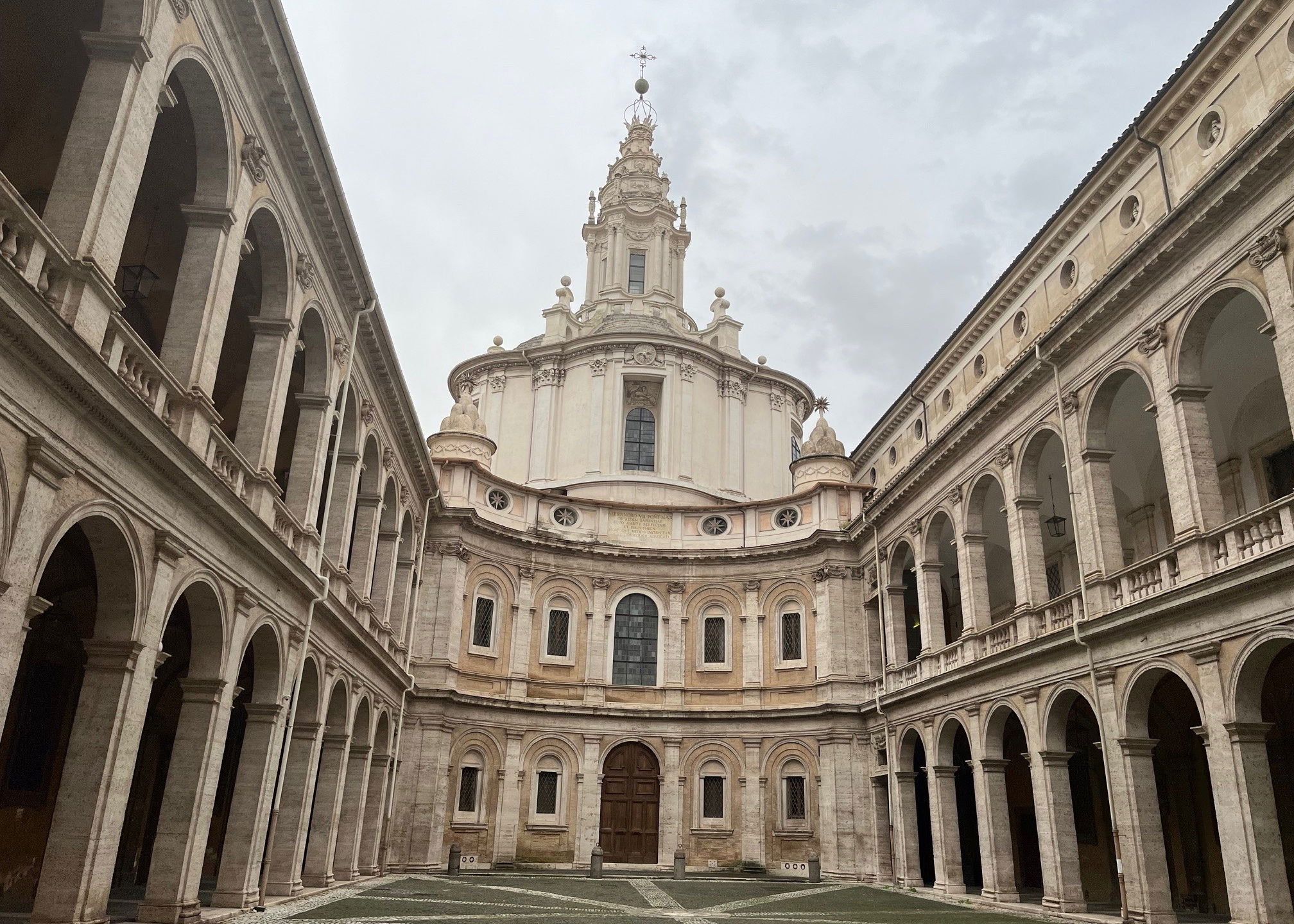
Sant'Ivo alla Sapienza
From there Thannhauser walked the short distance to Piazza Navona to look at Bernini’s Fontana dei Quatro Fiumi. Gian Lorenzo Bernini designed the masterpiece in 1651 for Pope Innocent X, whose family home the Palazzo Pamphilli fronted the piazza Navona . Bernini was the leading sculptor of his age , credited with creating the Baroque Style. A genuine Renaissance man, he also dabbled in painting , the theatre and decorative art objects- Although Bernini left his mark with his architecture, especially St Peters and the colonnades in front of the Basilica, his work on fountains gives full reign to the decorative dynamism of the Baroque , with the aesthetic pleasure and emotional delight of running water in motion. The Fontana deli Quattro Fiumi was a masterpiece of spectacle, but also a political allegory. From the base of the fountain., travertine rocks rise to support four river gods representing four continents, the Danube ( for Europe), the Ganges ( for Asia) (for Africa) , the Nile and the Rio de La Plata ( the Americas).

Fontana dei Quatro Fiumi- Piazza Navona
Each River God has animals and plants that further identify their location . The river God representing the Ganges carries a long oar representing the river’s navigability, In between the Ganges God and his neighbour, the Nile God are a palm tree and a lion, both being common to Asia and Africa and connecting the two. The fountain also served as a propoagand tool for Pope Unncent X , with the four known continents being united under one giant obelisk Innocent X was bringing the whole world and four continents to the Piazza Navona The obelisk is topped by his family emblem the dove. However, it was not just there for decorative purposes, it had a utilitarian function as part of Rome’s public water system.
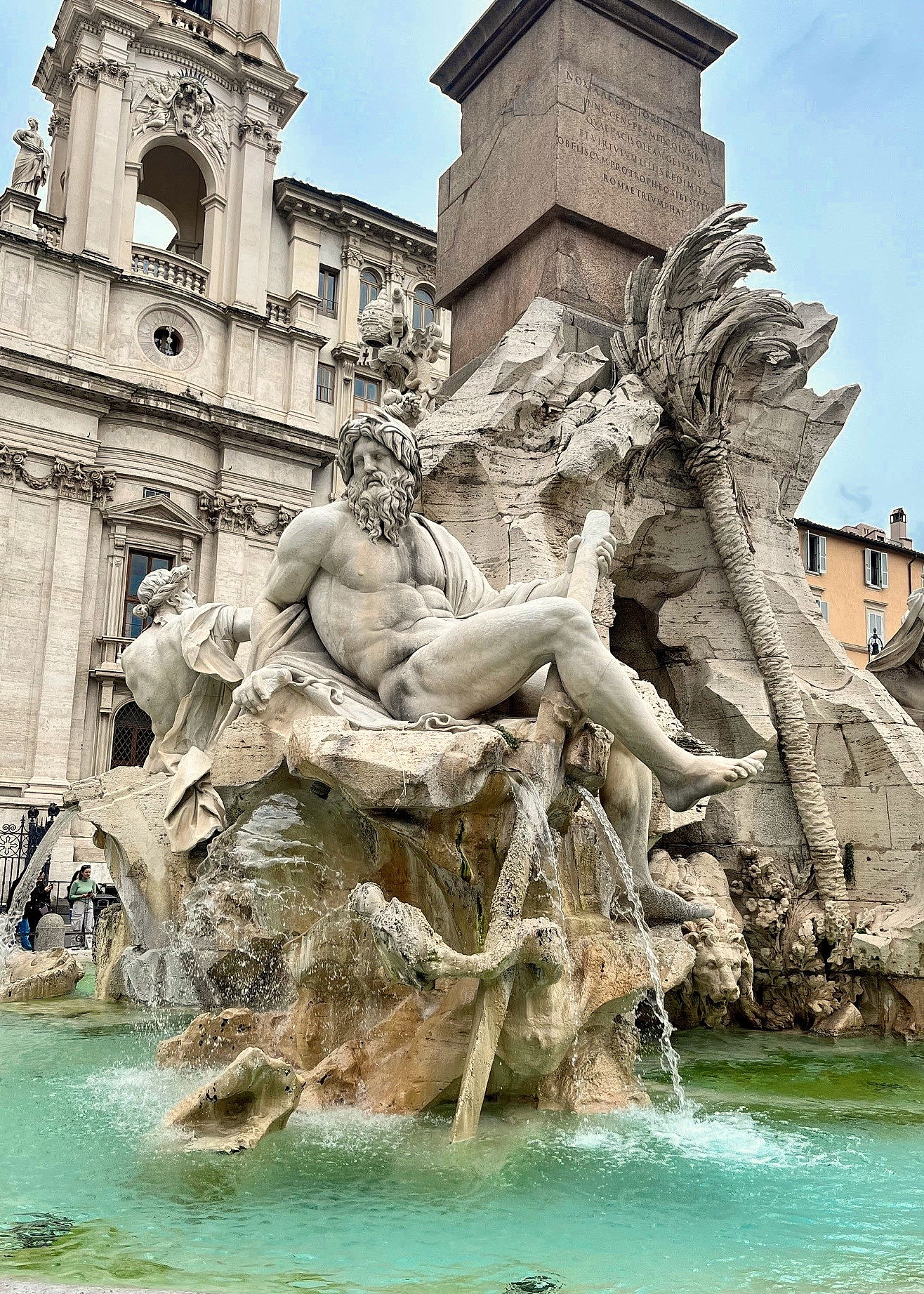
Fontana dei Quatro Fiumi- the River God of the Ganges
Facing the piazza , Sant’ Agnese in Piazza Navona is a 17th-century Baroque church supposedly on the site where the Early Christian Saint Agnes was martyred in the ancient Stadium of Domitian. The building of the church was begun in 1652 at the instigation of Pope Innocent X whose family palace, the Palazzo Pamphili was next door. (The church was intended as a family chapel accessible from their residence The first designs were prepared by the Pamphili family architect, Girolamo Rainaldi, and his son Carlo Rainaldi in 1652. They reorientated the main entrance to the church from the Via Santa Maria dell’Anima, to the Piazza Navona, a large urban space that Innocent was transforming into a showcase associated with his family. Harsh criticism was made of the design, including the steps down to the piazza which were thought to project excessively, so Carlo Rainaldi substituted a concave facade so that the steps would not be so intrusive. The idea of the twin towers framing a central dome may be indebted to Bernini's bell towers on the facade of Saint Peter's basilica. Nonetheless, Rainaldi’ s design of a concave facade and a central dome framed by twin towers was influential on subsequent church design in Northern Europe. In 1653, the Rainaldis were replaced by Borromini, who worked with the Rainaldi ground plan but adjusted the interior. Borromini became disheartened and resigned in 1657. Carlo Rainaldi was reappointed and made a number of modifications to Borromini's design including an additional storey to the flanking towers and simplifying their uppermost parts. On the death of Camillo, his wife Olympia (Aldobrandini), commissioned Bernini to take over.
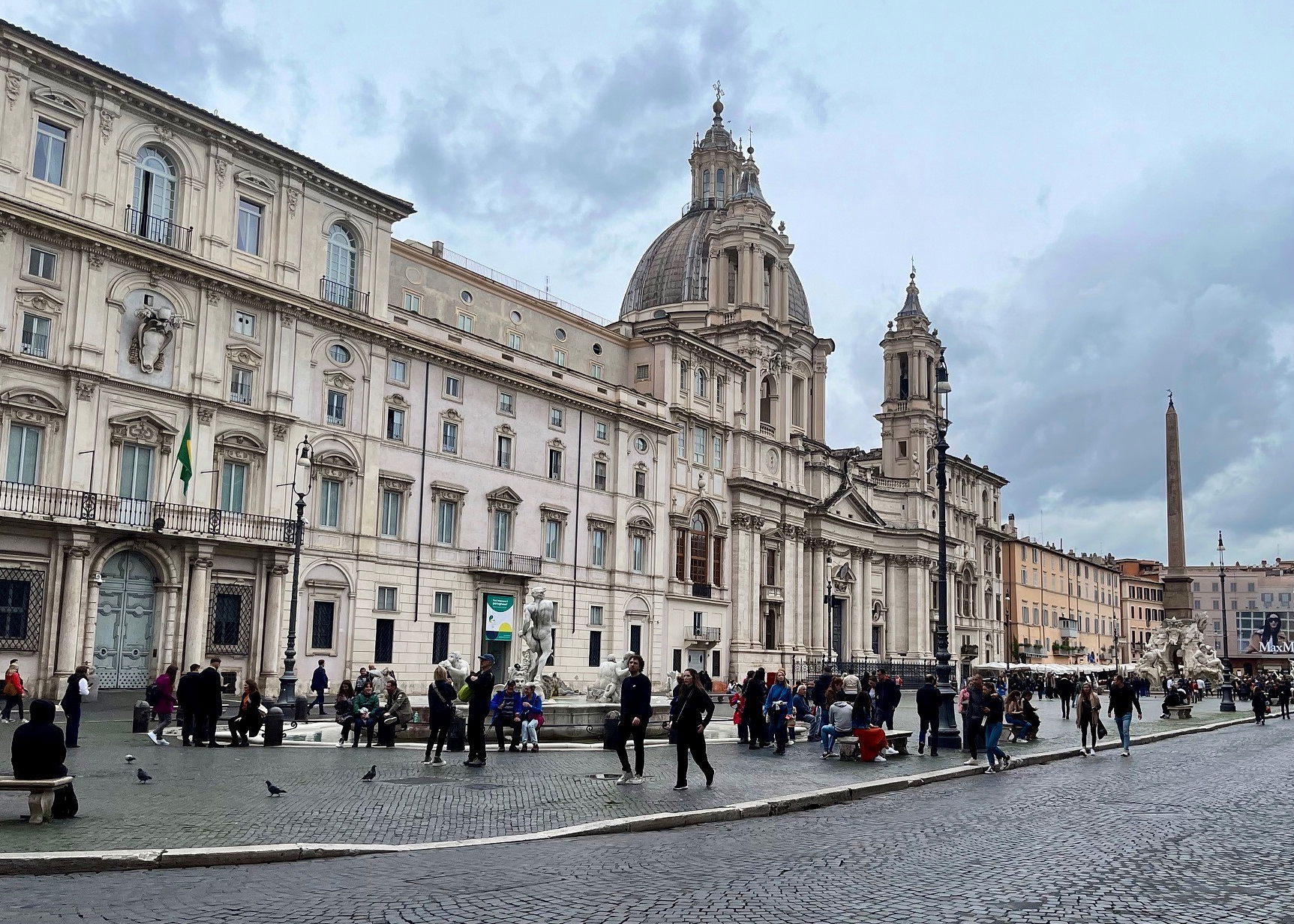
Heading away from piazza Navona at the intersection of Corso Vittorio Emanuele and Corso Rinascimento , Thannhauser reached Sant’ Andrea della Valle, which was renowned for its Baroque cupola by Lanfranco and its ceiling decorations. The church was initially planned when, in 1582, Donna Costanza Piccolomini d'Aragona, duchess of Amalfi and descendant of the family of Pope Pius II, bequeathed her palace and the adjacent church of San Sebastiano to the Theatine order for construction of a new church. Since Amalfi's patron was Sant ’Andrea, the church was planned in his honor. Work started around 1590 under the designs of Giacomo della Porta and Pier Paolo Olivieri, and under the patronage of Cardinal Gesualdo. After a break, work restarted in 1608, financed by what was then an enormous endowment of over 150,000 gold scudi, and the interior of the church was completed by 1650, with some changes added by Francesco Grimaldi.
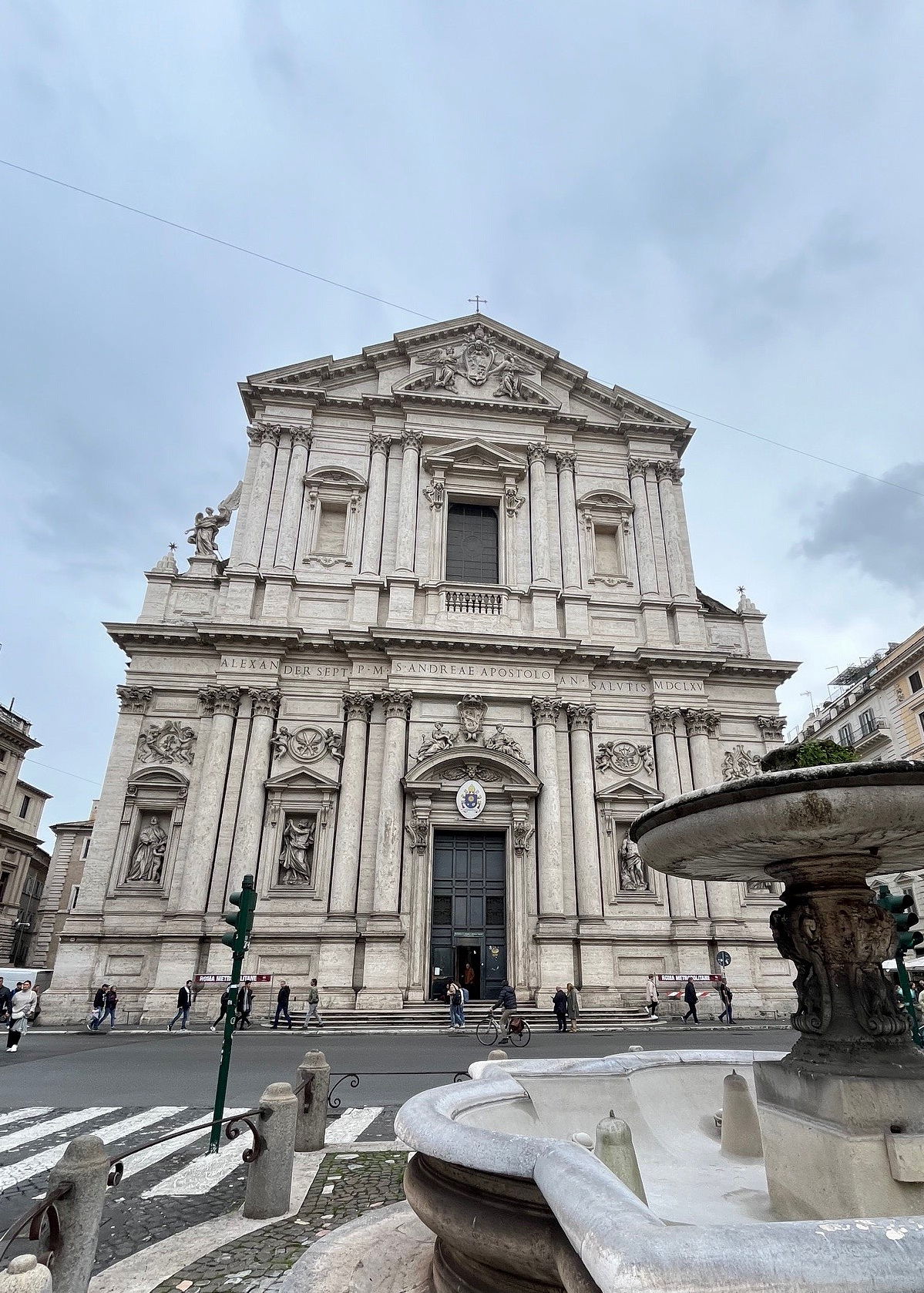
Sant’ Andrea della Valle
The fresco decoration of Sant ‘Andréa’s dome was one of the largest commissions of its day. The work was disputed by two Carracci pupils, Giovanni Lanfranco and Domenichino. In 1608, Lanfranco had been chosen by Cardinal Alessandro, but the Ludovisi papacy of Pope Gregory XV favored the Bolognese Domenichino. In the end, both artists were employed, and Lanfranco's lavish dome decoration (completed 1627) set the model for such decorations for the following decades. The dome was for a long time the third largest dome in Rome, after the Basilica of St Peter and the Pantheon.
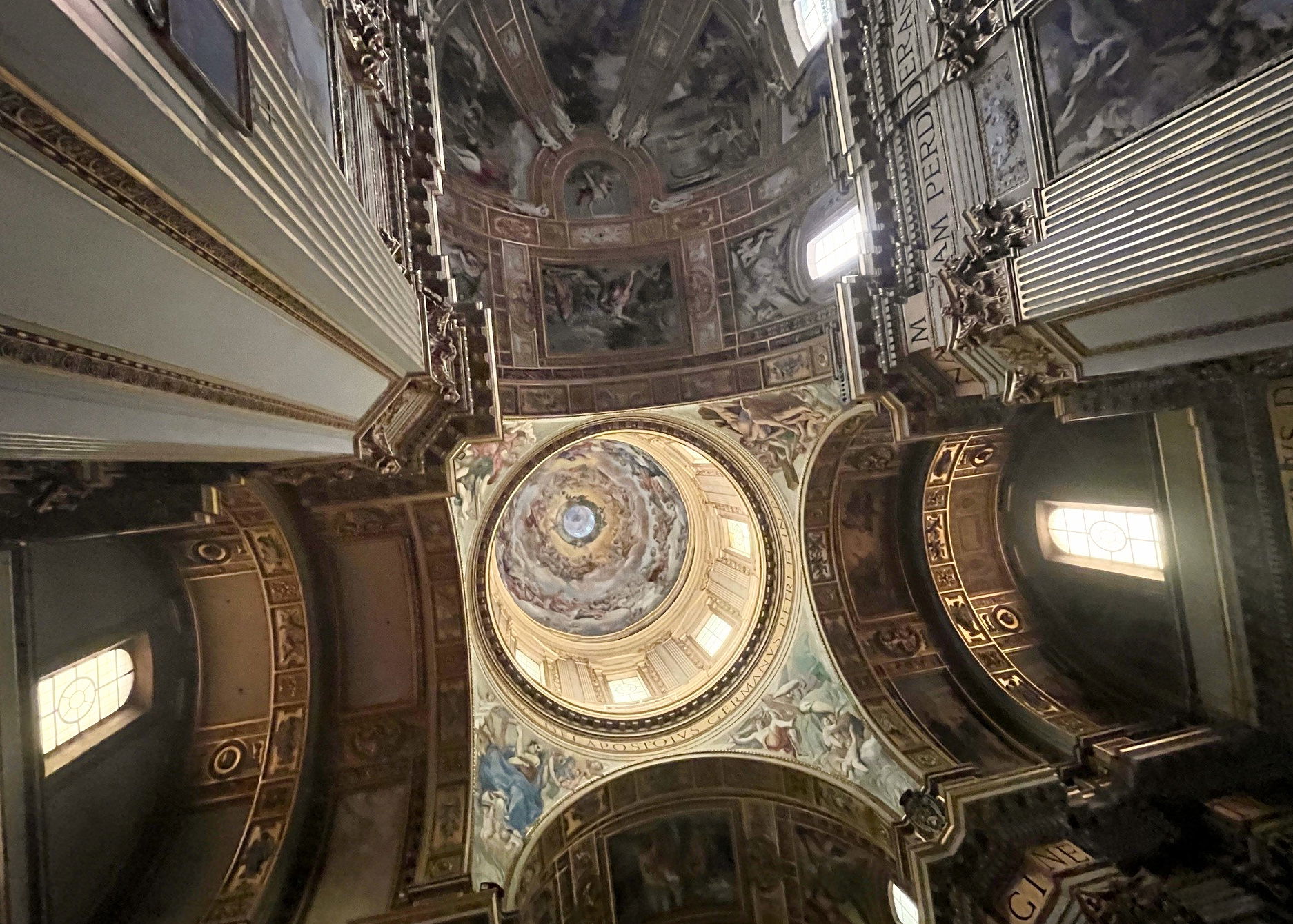
Lanfranco's Cupola in Sant’ Andrea della Valle
To be continued on next trip to Rome.........